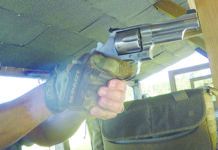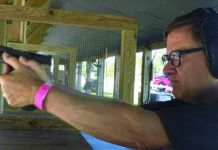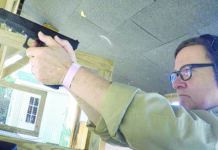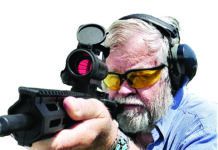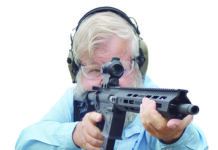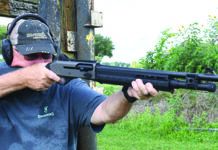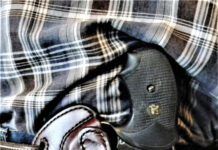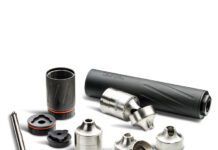How do you succeed in at least approaching the levels of accuracy you’d like? It’s common knowledge in accuracy circles that although correctly mating the barreled-action and stock will usually shrink groups from factory rifles, the greatest improvement (short of screwing on a custom barrel) typically comes from working up a good handload. In fact, a firm that specializes in accurizing factory hunting rifles recently noted that compared to factory ammunition, optimum handloads often trim group sizes in half.
The term “working up a good handload” conjures an image of nothing more than arriving at the right bullet driven by the correct powder charge touched off by the proper primer. What tends to be overlooked is the issue of improving the cases and then assembling the rounds with precision and consistency. Precision reloading is precisely what we’ll be dealing with here as we take a good look at the various reloading tools, as well as case-prepping devices and the techniques for using them. The following information is intended for bolt-action and single-shot rifles. Semiautos, lever actions and pumps have their own special requirements, which are not addressed here.
Fortunately, shooters looking to brew better handloads can shortcut the learning process simply by borrowing from benchrest technology. The accuracy levels achieved by benchrest competitors leave no doubt they know what they’re doing. However, as you’ll see, benchrest case preparation and loading procedures range from excellent to questionable to really weird. Consequently, we need to sort the sensible from the absurd and adopt the most practical practices for our own use.
Weighing Cases
Before reloading begins, it’s essential to go over our cases. There was a time when benchrest shooters wouldn’t dream of shooting cases that hadn’t been carefully sorted by weight. Now, largely due to the wonderful consistency of case manufacture, the practice is emulating the fate of the dodo. Still, many of us find comfort in weighing our cases and weeding out those that are extremely light or heavy. For one thing, such variances may indicate wall-thickness problems that could affect accuracy. Also, worrisome is the possibility that glaring weight differences will to some degree influence case volume and thus cause velocity disparities. The question is, at the typical distances most of us direct our bullets, will a small variation in a case’s boiler room really make a measurable difference? Probably not, but since we’re searching for every practical advantage, let’s play it safe and shoot cases that weigh approximately the same.
Flash Hole Clean-Up
Deburring flash holes to remove any jagged protrusions and ridges in and around the hole resulting from case manufacture is a fine idea. The practice stems from a sensible belief that defects here compromise ignition, creating some of the inconsistencies we’re striving to eliminate. The trick is to clean up the hole and the metal surrounding it with minimal mutilation of the case web.
Inexpensive deburring tools, such as Lyman’s, are available for this operation, and they do a dandy job. But, if you have drill bits on hand, these work fine too. To cut away the undesirable ridge around the hole (inside the case), choose the largest bit that will slide through the case neck and turn it with your fingers to prevent funneling significantly into the web. Clearing the hole itself can be done with a bit that fits snugly. As in all case-preparation procedures, consistency is everything, so do your best to deburr all cases identically and simply make sure any obvious abnormalities are corrected.
Primer Pocket Uniforming
Cutting primer pockets to a uniform depth is one of the more recent innovations in precision reloading. In theory, it appears very sensible. After all, if primers in all your cases rest at the same depth, logic suggests the firing pin will travel an identical distance to strike each primer, thus adding to the kind of consistency in the firing sequence you’re seeking. Yet another perceived advantage involves cutting a flat, precisely trued pocket floor to support the primer evenly around its circumference. And while it all sounds ducky, variations in case-length dimensions, even among fire-formed cases that have been neck sized only, might easily offset our best intentions of standardizing the firing pin-to-primer distance. Any other supposed benefits are just as iffy.
Despite nagging doubts as to its legitimacy, we confess to religiously performing this step on all cases. It should, however, be done in great moderation. Adjust the depth of the cutter so it just cleans up the outer perimeter of the primer pocket floor. Drilling too deeply results in primers resting abnormally deep in their pockets. As a veteran benchrest competitor and gunsmith recently observed, this has the unwanted effect of shortening the firing pin. He has a valid point. The striking mechanism is adjusted rather carefully by the rifle manufacturer, and altering the involved dimensions can possibly lead to ignition problems.
Tools that uniform primer pockets nicely are available from Sinclair, Whitetail, Hart, Lyman and Russ Haydon.
Neck Turning
Outside turning the necks of cases to be fired in SAAMI-dimensioned chambers is one of the more controversial case “improvements”. Granted, neck turning is unanimously practiced by benchrest shooters and enthusiastically endorsed by hordes of other accuracy fanatics. But, these guys are using tight-neck chambers, and besides improving accuracy, another small consideration is if the deed isn’t done, loaded rounds are too fat at the neck to be chambered!
A handloader who really knows his stuff can turn case necks that vary in wall thickness all around of a tiny 0.0001 inch or so. Is this important? Good question. Although hard-line advocates of tight-neck technology would shriek a loud “yes”, the jury is still out as to whether it does anything at all for factory-chambered rifles. And, in fact, there are ominous rumblings that outside turning necks for SAAMI-dimensioned chambers actually harms accuracy.
How can that be? Let’s explore some possibilities. It seems reasonable that a uniform wall thickness all around the neck will allow it to expand evenly during the firing sequence, cleanly releasing the bullet and thus helping assure that the bullet passes through the throat into the barrel precisely straight. A near-perfect neck also would help assure that the bullet ends up straight in the seating operation. If this is so, why wouldn’t turned necks work wonders inside an industry-standard chamber? We can only speculate that thinner brass at the neck, regardless of how precisely it’s been trued, allows the bullet more space to possibly “tilt” as it first begins moving forward during firing.
Theory further suggests that tilting (a condition in which the bullet is crooked to the bore line) also occurs more readily because the flimsy neck is more easily slammed against the chamber walls by gas pressure and therefore offers the bullet less support. In contrast, the thickness of unturned necks may effectively limit the space for tilting while supporting the bullet more firmly during the firing cycle.
Other evils of outside neck turning cited by those who regard the deed as sheer folly in factory guns are that necks split sooner from fatigue, and special dies may be required to size the thinned case necks. This certainly is true. All things considered, we advise against employing this step for factory chambers.
For those hardy souls who plunge ahead, we’d suggest the most practical plan of action is to adjust the tool so only the highest spots (thick areas) of necks are partially removed. By not completely “cleaning-up” necks, you achieve some degree of truing without appreciably thinning the brass. Granted, this amounts to a compromise, but it just might give better odds of improved performance than fully turned necks. Regardless, we recommend the neck-turning tools preferred by benchresters, such as Sinclair, Hart, Marquart and K&M.
Culling Bad Necks
In our opinion, a more practical solution to inconsistent neck thickness is to carefully measure each neck all around with a good tube micrometer and discard cases with undesirable variances. This way, you avoid the rather daunting task of neck turning and yet achieve much of the same results. Frankly, we have a hunch that you’ll experience better accuracy than with tediously turned necks.
Case Trimming
Case-length trimming is a universally practiced handloading procedure. It’s also among the simplest. In addition to maintaining cases at the correct length, proper trimming cuts the end of a neck evenly all around, perhaps to some inconsequential degree contributing to bullet-seating uniformity and to the consistency of neck grip on the bullet. Case-length gauges of various types are commonly available, and it’s certainly worthwhile to monitor and correct the growth of cases to make sure the necks don’t lengthen into the chamber shoulder at the beginning of the throat. Before trimming, and especially before chamfering, be sure to size cases to make the necks nicely circular.
Neck Chamfering
Beveling the sharp inside edge at the end of a case neck and lightly cutting away projections on the outer edge seems like a small thing. And, while it isn’t rocket science, it is very important, particularly after neck trimming. Properly done, the bevel on the inside edge of a sized neck will slightly exceed the diameter of the bullet and thus will effectively funnel it into the neck. If you chamfer the neck until it becomes sharpened, you’ve overdone it a bit.
Agreed, proper chamfering permits a bullet to slide into the neck without case damage. But looking at it from the standpoint of accuracy, it also helps prevent bullet injury. Prevailing opinion in accuracy circles is that shearing away a portion of the relatively fragile pressure ring on flat-base bullets during the seating operation does absolutely nothing good for group size. Of less concern is potential damage to the various boattail designs, which tend to wedge more easily into case necks.
Chamfering tools are offered by most of the major reloading equipment companies, and all perform this simple task well.
Case Base Truing
Another new and somewhat questionable wrinkle in precision reloadery is trimming—and thereby squaring—the bases of cases. To our knowledge, this step can only be done with a Wilson neck trimmer, which uses a shell holder to contain the case. Position a shell holder-contained case in the usual direction, and you’re ready to trim the neck length. Turn it around to trim the cartridge base. The thinking behind this step is that a cartridge base that is cut flat and squarely perpendicular to the center line of the case will flush-up nicely to the bolt face, preventing the base from exerting uneven pressure against the bolt. Rumor has it that in the firing sequence this malady wedges the bolt to one side or another, contributing to poor accuracy.
Although whittling case bases may inspire awe among one’s shooting peers, we should mention that factory bolt faces are rarely true, so chances are overwhelming that touching-up bases amounts to a colossal waste of time. Moreover, if the operation is carried out with excessive zeal, primer pockets may need to be deepened with a uniformer so the primers won’t protrude. All things considered, we enthusiastically recommend you ignore this step.
This completes the case-preparation phase, although neck trimming and chamfering will need to be repeated as necessary. Now we advance to the reloading process.
Case Sizing
Among benchrest competitors, there’s no consensus of how case sizing should be done. Many of these folks neck size only until cases become hard to chamber and extract, at which point they trot out full-length sizing dies made by Wilson or Redding, or a custom tool such as crafted by Clarence Hammonds, which “bumps” case shoulders back a few thousandths of an inch. Others employ a full-length or bump die every loading, contending that the resulting effortless bolt operation permits faster shooting during competition, a philosophy intended to enable a contestant to hurry all his shots away before the existing conditions change.
Granted, dissension in the benchrest ranks over sizing technique has little relevance to our purposes. Still, we can glean one important point: Despite long-prevailing assertions to the contrary, it’s now thought that full-length sizing is no less accurate than sizing necks only. So, you can take your choice and not fret about giving away precious accuracy.
If benchresters are all over the lot when it comes to overall case sizing, they find agreement in one area: It’s essential that case necks be sized for a specific amount of grip on the bullet and for as little grip deviation from round to round as possible. All of us would do well to hear what they’re saying.
Of course, anyone operating a repeater chambered for a blue-shoulder magnum is likely going to need the tightest bullet grip feasible, considering the effects of fierce recoil on rounds in the magazine. But, for gentler rifles, as well as single-shots of any ilk, you should try for a firm grip—not too tight, not too loose. What’s too tight? If a properly chamfered neck shaves copper from the heel of your bullets in the seating operation, it’s too tight. Ditto, if the neck bulges around the bullet like a snake swallowing a rat. What’s too loose? When seated bullets can be rotated with the fingers, more tension is needed.
Standard sizing dies from RCBS, Lyman and Lee are examples of the one-size-fits-all concept, with a single dimension in any caliber chosen to do the job on all makes of cases and slightly varying diameters between different bullet makes and designs. Of necessity, the tools size more than necessary.
Happily, there’s a better system. Wilson, Redding and Hart neck-sizing dies feature readily interchangeable sizing bushings in various diameters that allow picky shooters to achieve a desired bullet grip while working the brass as little as possible. The tools are offered with chambers to fit most standard cartridges and some wildcats. Redding and Hart sizers are threaded for presses, while the Wilson tool requires an arbor press or plastic hammer.
Seating Primers
Sseating primers precisely is a matter of feel, and you can sense the operation better with a hand tool, such as the Lee and RCBS types. A popular technique is to feel the primer slide into the pocket, then bottom out. With the primer touching bottom, you exert just a tad more pressure to “preload” the primer anvil, or so the theory goes. Perhaps the greatest benefit of going to this effort is that it encourages a handloader to focus on seating primers identically from case to case. Even if this small step isn’t single-handedly going to perform miracles, it’s another step toward our goal of uniformity in all things.
Adding Powder
Punching aspirin-dimensioned groups calls for precisely-weighed powder charges. Right? Wrong. Benchrest competitors simply throw their charges with powder measures, partly because today’s measuring devices produce excellent shooting results out to 200 yards, and partly because they’re fast and convenient. Of course, what makes them work so well are small-grain powders that flow through the devices like water, easily bracketing powder charges within the manufacturers’ claims of plus or minus 0.1 grain.
Although top-of-the-line custom powder measures made by Neil Jones or Lester Bruno fetch about $300, the Redding BR models do a fine job at one-third that cost. The more extravagant units feature convenient audible “click” adjustments. The Reddings have infinitely adjustable micrometer-type increments which work nicely but require lavish use of their owners’ bifocals.
Unfortunately, large-grain powders of the 4064, 4831 and 4198 variety pretty well gum up the works as the rotating drum bites into the oversized granules. Consequently, shooters who use such powders might be better off weighing their powder charges.
Seating Bullets
With case necks properly sized so they grip bullets just enough, and not a bit more, the challenge is then to seat bullets so they wind up pointing as straight as possible along the center line of the cartridge. If the neck-sizing and bullet-seating operations were flawless, bullets loaded in fire-formed cases would exhibit close to zero wobble when rotated in V blocks or a commercial runout tester. In the real world this rarely happens. Despite our best efforts with good equipment, sized necks nearly always exhibit some misalignment. Then, the bullet-seating step compounds the problem because no matter how precisely the seating die appears to have been engineered and machined, the case and bullet are not truly supported by the chamber walls, and therefore both can tilt slightly in the seating operation, spoiling all prospects of a near-perfect round.
But, does bullet runout in loaded rounds make a huge difference anyhow? If a poll were taken, there’s little doubt that a majority of precision handloaders would swear it does. A lesser number of shooters, who take their accuracy just as seriously, would counter that the benefits of minimal runout are vastly overrated. Their argument is that there’s no guarantee that a perfectly aligned bullet will pass through the throat and enter the barrel in that same flawless orientation, given the rough treatment the case neck and bullet are handed as gas pressure begins violently multiplying. They’d also argue that a sufficiently tight chamber throat will serve to funnel the bullet into the barrel relatively straight, regardless of bullet misalignment.
Then, there’s the issue of bullet-seating depth, which must figure into the equation. If the bullet is seated deeply, far from the origin of the lands, once the round has been chambered any severe misalignment will be limited only by the dimensions of the chamber neck and throat and the thickness of the case neck. On the other hand, if a bullet is seated against the lands, the lands themselves will tend to straighten it.
While this offers incentive for seating bullets into the lands, this technique has its disadvantages, including increased chamber pressures and the chance that in extracting a live round, a bullet jammed into the lands could be pulled, dumping powder into the action and requiring the use of a cleaning rod to tap out the bullet. Such incidents are amusing only when they happen to someone else.
Despite the drawbacks, best accuracy is generally achieved with bullets either to some degree touching the lands or seated just a few thousandths of an inch away. If there’s no significant difference in accuracy, it might be safest to leave bullets not touching.
Experimentation with bullet depth is simplified with a Stoney Point OAL (overall length) gauge, an ingenious measuring device that allows precise seating in relationship to the lands. Or, the handloader can assemble a dummy round, either polishing, smoking or felt pen marking the bullet ogive so scratches made by the lands can be easily seen. Starting with the bullet touching the lands, it’s gradually seated deeper until the lands no longer engrave it.
Regardless of the technique used, noting the approximate point at which the bullet clears the lands is greatly simplified by the micrometer feature on the competition-style seating die available individually from Redding. The micrometer system is also invaluable when several types of bullets are used in one rifle. By recording a setting for any bullet, that setting can be accurately recalled at any time.
Wondrous examples of bells-and-whistles technology, such as Redding’s seating die, surely must pose a ceaseless temptation to those obsessed with accuracy. Even so, the benchrest workhorse remains the ageless Wilson bullet seater, operated with an arbor press or hand pressure. Although its adjustment consists of nothing more elaborate than a threaded rod with a lock screw, its wide acceptance attests to the fact that it performs quite well, thank you.
Summing It Up
If from all this you’ve concluded that precision reloading is little more than tedious methodology clouded by disagreement, you basically have it right. However, the contrasting opinions voiced by handloading perfectionists are by no means unexpected. The fact is, a tweak that works well in one rifle may do absolutely nothing for another. This merely underscores the maddening individuality of each rifle and at the same time explains why one shooter may warmly embrace a procedure while another curses it.
Conflicting views aside, the indisputable fact remains that a handloader can’t go wrong when he assembles every cartridge with all the precision and care he can beg, borrow or steal. Even in the unlikely event that lovingly assembled handloads wind up doing little or nothing for the accuracy of a specific rifle, at least the reloader has gone the extra mile to give a gun its very best opportunity to perform. In the view of many enthusiasts, that justifies the extra effort and expense.




